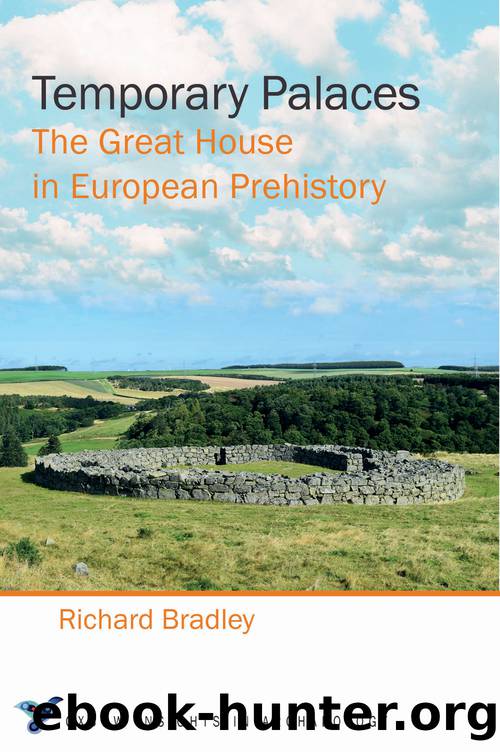Temporary Palaces by Bradley Richard;

Author:Bradley, Richard;
Language: eng
Format: epub
ISBN: 6531346
Publisher: Oxbow Books, Limited
Published: 2021-09-15T00:00:00+00:00
The growth of Late Neolithic buildings
The Grooved Ware network featured more than one type of domestic building, but only the commonest form is considered here. It was also the most widely distributed. The best preserved of these structures were in Orkney where they were built of stone; they may have included the earliest examples. There was a striking contrast between their external and internal appearances. Seen from outside, they were generally oblong or circular (although they occurred on a few sites with long oval structures). The interior was usually rectilinear, with a square central hearth and a series of recesses set into the wall. The entrance was generally towards the southeast and faced the rising sun (Richards 2005; Richards & Jones 2016).
If Grooved Ware houses in Orkney were built from local sandstone, their counterparts in other regions were usually constructed of timber. This reflected the quality and availability of the most suitable material. The characteristic layout of the dwellings at sites like Barnhouse and Skara Brae was also rendered in wood. The hearth itself rarely survives, but the central part of the building is represented by a square or rectangular setting of posts, while the outer wall can be identified as a circular or oblong arrangement of postholes or stakeholes. Reconstruction of a roundhouse of this kind at Greenbogs showed that it was comparatively easy to build and that the central setting helped to support the roof (Noble et al. 2012). Such buildings were usually smaller than those of the later Bronze Age and Iron Age. Late Neolithic examples could be associated with pits containing formal deposits of artefacts and animal bones, but these comparatively slight buildings are so uncommon that it is difficult to decide if this was a general pattern.
Their characteristic form was reproduced at a variety of scales, and in a range of different contexts, from settlements to ceremonial centres. Their relationship to one another is obscured by the current terminology, so that the smaller examples are described as âhousesâ and the largest as âtimber circlesâ (A. Gibson 2005; Pollard 2009). In fact there is a continuum from ephemeral domestic buildings to the largest buildings inside henge monuments. In between those two extremes there were impressive examples like those at Ballynahatty (Hartwell 1998), Armalughey (Carlin 2018, 137â44), and Machrie Moor (Haggarty 1991). The first of these was inside a palisaded enclosure, but the others were freestanding (Fig. 20). Their associations varied from site to site. They were constructed around the exterior of the passage grave at Newgrange (Brindley 1999, fig. 3.6) and in front of the entrance to the tomb at Knowth where the building was associated with carefully placed deposits of artefacts (Eogan & Roche 1997, 101â201).
Download
This site does not store any files on its server. We only index and link to content provided by other sites. Please contact the content providers to delete copyright contents if any and email us, we'll remove relevant links or contents immediately.
Room 212 by Kate Stewart(4736)
The Crown by Robert Lacey(4572)
Endurance: Shackleton's Incredible Voyage by Alfred Lansing(4505)
The Iron Duke by The Iron Duke(4122)
The Rape of Nanking by Iris Chang(4022)
Killing England by Bill O'Reilly(3897)
Joan of Arc by Mary Gordon(3782)
Say Nothing by Patrick Radden Keefe(3725)
I'll Give You the Sun by Jandy Nelson(3272)
Shadow of Night by Deborah Harkness(3174)
Hitler's Monsters by Eric Kurlander(3164)
Mary, Queen of Scots, and the Murder of Lord Darnley by Alison Weir(3064)
Blood and Sand by Alex Von Tunzelmann(3055)
Darkest Hour by Anthony McCarten(3018)
Margaret Thatcher: The Autobiography by Thatcher Margaret(2971)
Eleanor & Park by Rainbow Rowell(2943)
Red Famine: Stalin's War on Ukraine by Anne Applebaum(2816)
Book of Life by Deborah Harkness(2718)
The One Memory of Flora Banks by Emily Barr(2684)
